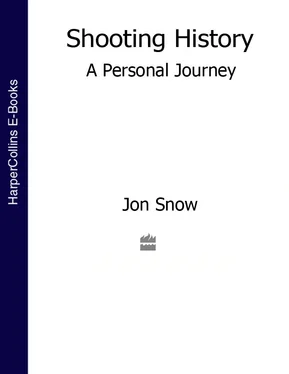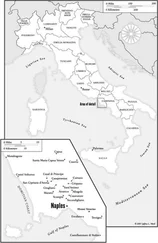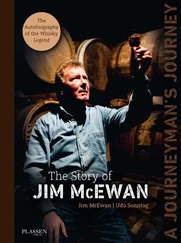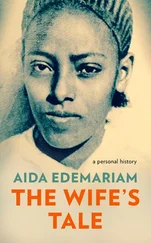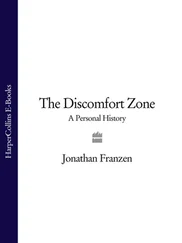India in the summer of 1969, singing ‘Hey Jude’ in the Liverpool University close-part harmony Beatle band.
Pre-mobile-phone reporting for LBC in 1973, on a clunky old Motorola two-way radio.
An exchange with Ugandan dictator Idi Amin on the 1974 trip with Jim Callaghan to rescue Denis Hills.
Vietnamese boat people below decks on the refugee boat on which we found ourselves stranded in the South China Sea in 1976.
The shell of the Vietnamese refugee boat beached in Malaysia.
Interviewing the Somali President Siad Barre, a grumpy Moscow-educated ideologue running a classic Cold War Russian client state, in 1976.
With Mohinder Dhillon in Somalia. Mystified British viewers were treated to a travelogue in which an excitable white man jumped up and down talking about the threat to world peace.
Back to Uganda again in 1977, this time for ITN armed with Edward Heath’s book.
Interviewing US President Jimmy Carter and Prime Minister Jim Callaghan outside Lancaster House in London, 1977.
Preparing to conduct the first ever English-language interview with a Pope, aboard John Paul II’s plane in January 1979.
Afghanistan, 1980. With the Mujahidin in mountains above Herat in the immediate aftermath of the Soviet invasion.
Filming with Charlie Morgan at ‘Desert One’ in Iran in April 1980 amid the wreckage of Jimmy Carter’s catastrophic attempt to rescue the American hostages.
The Iran–Iraq War in 1981. Wearing no body armour and no flak jacket, I was less than well prepared to survive the conflagration in which I was caught.
With President Reagan in the White House, February 1985.
Interviewing Nelson Mandela the day he became South Africa’s first democratically elected President in 1994.
On the line in northern Ghana, exploring the Greenwich meridian in a classic ‘Yendi smock’ in 2000.
With cameraman Ken McCallum in Baghdad, November 2003.
Advertising Channel Four News, with trusty steed on Euston station.
Prologue
THE BOAT stood proud against the horizon, its curved bow and stern silhouetted on the skyline. We had been looking for it for a day and a night. As we drew near, what we had thought were ornate outcrops from the deck of the boat materialised into the bobbing heads and shoulders of a mass of human beings. The vessel was no more than forty feet long, but there were hundreds of people packed aboard it.
We had set out that morning in November 1978 from Trengganu on Malaysia’s north-eastern coast aboard a fast local fishing launch. I was with my Swedish cameraman Claus Bratt and, somewhat unexpectedly, the books editor of the Daily Mail, Peter Lewis. Our quest was to encounter one of the myriad craft bearing refugees out of Vietnam across the South China Sea. These were the ‘boat people’ who in the previous few months, in their tens of thousands, had left the Vietnamese coast aboard almost anything that would float. The Vietnam War had ended three years earlier, but the flow of refugees was undiminished, orchestrated by traffickers and by the myth that America was waiting with open arms for any who fled.
The boat was well down in the water, with no obvious accommodation beyond a wheelhouse and two corrugated sheds at the back which were clearly lavatories. I urged the fisherman who’d brought us to take us closer so that I could engage the captain in conversation. Eventually we came alongside, and Claus and I boarded the boat. At that precise moment our fisherman panicked, fearing that some of the Vietnamese might try to jump onto his vessel. He suddenly thrust his engines to full, pulled away from us, and sped off whence we’d come. I could see the Daily Mail’s books editor remonstrating furiously in the stern. Soon the fishing boat was but a speck in the distance.
There was almost no room to move on deck. We peered down into the cargo holds, and dozens of faces, young and old, boys, men and women, looked up expectantly. Many seemed to be very sick. Claus and I were led with difficulty towards the captain, who was at the wheel in the stern. I calculated that there were at least 350 people aboard a vessel that might have comfortably carried thirty. They had been at sea for the worst part of three weeks. The smell was overpowering; the dead body of an elderly woman wound in a sheet lay against the gunwale. The boat people seemed to assume that we were the advance guard of a welcoming party headed by the US Ambassador that would be waiting ashore with passports ready to usher them all to their new lives in California.
We’d been sent by my editor at ITN in London to find out how this huge exodus of people from Vietnam operated, and who was facilitating it. Until now, such boats had been seized the moment they made landfall in Malaysia; the boat people aboard would be rounded up and carted off to a kind of concentration camp run by the UN further up the coast on the island of Palau Badong. Consequently it had proved impossible to get to the root of how their journeying had come about.
The captain, a rotund ethnic Chinese, spoke excellent English and was candid about how much each person had paid – the equivalent of $2000 a head, extracted mainly from gold dental fillings and melted-down family heirlooms. He was more vague about how or where they were going to land in Malaysia; indeed, he thought he might even be off the coast of Indonesia. I asked him if anyone could swim; he thought not. There appeared to be no food on board, and the lavatories had become a foetid disaster zone, from which we tried to keep as far ‘upship’ as possible.
Towards nightfall we had our first glimpse of land. The captain decided to make a run for the shore. Within moments we were greeted by a hail of rocks and sticks, hurled by irate ethnic Malays who seemed to come from nowhere and swarmed out along the beach. The defenceless Vietnamese trapped on deck were being cut about their heads, and worse. Our boat turned broadside across the rollers, and threatened to capsize before finally making it through the surf and back out into the open sea.
We advised the captain to try further up the coast at first light, in the hope that any reception party would not yet be about. A ghastly night passed before we renewed our run at the beach. I suggested to the captain that he rev the engine to its maximum, and try to burn it out as the vessel beached. This way I hoped we could avoid being pushed back out to sea again. Claus had by now secured remarkable film of everything that had happened, an unprecedented record of the tribulations in the lives of fleeing Vietnamese boat people.
The noise of the screaming engine summoned a new batch of Malays down the beach, and another fusillade of projectiles. The engine blew, sure enough, but before the captain had succeeded in beaching the boat, which was now skewing dangerously in the surf. I grabbed a rope from the bow and leapt into the water, trying to lug the waterlogged hulk ashore. Gradually the sea itself seemed to bring it in.
Suddenly I was grabbed from behind and thrown beneath the water. Someone took hold of a hank of my then long hair and dragged me to the beach. I was spreadeagled on the sand while one man stamped on my arms and another beat me about the chest with a pole. Claus, still cradling the wreck of his camera, blood pouring down his face, was thrown down beside me. Malaysian soldiers stood idly beneath the palms at the top of the beach, watching the Malays assaulting the boat people. Nearly all the victims were ethnic Chinese. I learned later that the Malay/Chinese balance in Malaysia was fragile in the extreme, and that Malays would go to any lengths to prevent the expansion of the Chinese population.
After what seemed an age, the police came and arrested Claus and me. Snapping handcuffs on our bruised wrists, they threw us into the back of a caged pickup truck. At Trengganu’s police station, the chief informed us that we were to be charged with aiding and abetting illegal immigration, an offence that carried a twenty-year jail sentence. We found ourselves in a disgusting fifteen-foot-square concrete cell with a steel door and a small barred window. The floor was awash with urine and faeces. In the gloom I counted eight others already inside. One of them turned out to be our battered captain, Lee Tych Tuong. Mr Tuong, it turned out, was a former printer who had never touched a boat in his life before. It had taken him and some of the other escapers eight months to build the vessel. He told us how they had become completely disorientated upon leaving Vietnamese waters, and how dysentery had claimed half a dozen lives during the voyage.
Читать дальше
